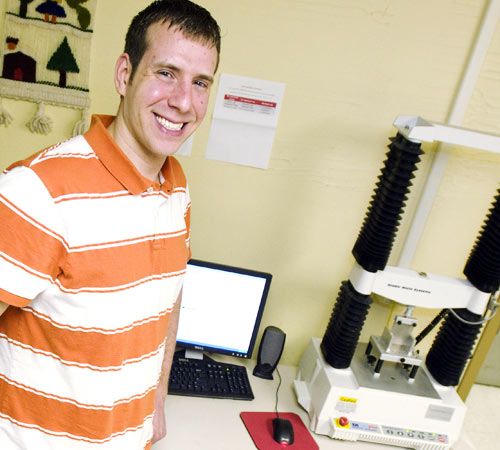Student brings home the bacon

February 3, 2009
Have you ever asked yourself how a pig becomes a pork chop? Or have you wondered who ensures that the T-bone steak that reaches your dinner table comes from a healthy animal?
If you have, then Sean Holmer is your man. And make no mistake about it, he loves the science of preparing meat for consumption and, with scholarly detail, can go on and on about it.
“My friends probably can’t stand me,” Holmer said with a chuckle. “I can talk about this stuff for hours.”
He’s particularly interested in ensuring the pork chops, ribs and steaks are as tender as possible. In fact, it’s his primary area of research and he’s even dedicated his dissertation to the subject. “The textural properties of pork,” to be precise.
Holmer has been at the University for eight years, earning a B.S. and an M.S. in animal sciences along the way. Within the next six months, he also hopes to have earned a doctorate in the subject. For seven of those years, he’s been working in the Meat Sciences Lab.
Get The Daily Illini in your inbox!
A significant aspect of his work involves a process delicately called “harvesting.” It’s an industry term used to describe the process of euthanizing an animal, dismembering the carcass and preparing it for consumers in the form of bacon, spare ribs and other cuts of meat. Some may simply refer to this as killing or butchering the animal.
Everything takes place on the Abattoir, a large open space with huge industrial machines that give no indication of their function until they’re actually used. The laboratory is federally licensed to harvest cattle, pigs, sheep and poultry.
Inside the Abattoir
This morning, 10 pigs are up for harvesting. As the pigs are walked into a closed-off area one by one, Holmer explains the process.
Chuck Stites, manager of the meat lab, takes the end of an electrical stunner and places it on the back of the pig’s neck, dropping the animal to the floor instantly.
“The pig doesn’t feel anything,” Holmer assures me. “It doesn’t know what’s going on or anything.”
Stites then chains the pig around one of its legs, and a machine lifts it near a large plastic can, at which point Holmer warns me “you might want to turn around if you’re a little squeamish.”
I didn’t. Stites exsanguinates the pig by sticking a knife in its neck, causing it to bleed profusely. A few minutes later, the lifeless pig is lifted into a scalding tank and lifted again into one of those mammoth industrial machines where its hair is removed. From there a two-man crew of students removes any remaining hair with hand knives. Once everyone is sure the pig is hairless, the carcass is eviscerated and inspected by a state official to make sure the meat is safe for the market.
Harvesting is not for the faint of heart. But in Holmer’s view, it is necessary.
“It’s a process to gain a meat product that we’re going to use for human consumption,” Holmer said. “It’s a process that has to be undergone. It has to happen.”
The passion with which Holmer discusses his craft would make it sound like he’s a farm boy. However, neither he nor his parents are from agricultural backgrounds, and Holmer hadn’t taken any classes related to his current field of study before enrolling at the University. It was only during an internship at a veterinary clinic in his final semester of high school that he discovered his interest in animals. Initially, he wanted to be a veterinarian, but changed his mind when he arrived at the University in 1999 and decided on animal sciences instead.
Since then, he’s interned at large meat companies and has written several scholarly articles that have been published in industry-related journals. When he’s not in the lab, he’s a teaching assistant for statistics classes. Last year, he won the Baker Fellowship, a one-year full tuition and fee award given to a high-achieving animal sciences doctoral student.
“He’s as good as they come,” John Killefer, professor of animal sciences, said of Holmer.
Killefer, who has known Holmer since he was an undergraduate student, is his advisor and sits on his dissertation committee. He lauds Holmer’s academic ability and proudly listed off his achievements outside of the classroom.
“I’ve always felt that Sean has had great potential and I don’t think I was mistaken on that one,” Killefer said about meeting Sean seven years ago. Still, Holmer has yet to decide in which job sector he will focus that potential. He’s applying for several assistant professor positions at universities across the country.
He said many meat companies have research and development groups that make ready-to-eat food products, and that he may find employment there. Or perhaps a gig in the federal government. He’s not sure. Given the current economic situation, Holmer is not going to be picky either.
“I’m hoping there will be some positions open somewhere,” he said.
But given how positively his professors speak of him, there’s likely a job out there with his name on it.






